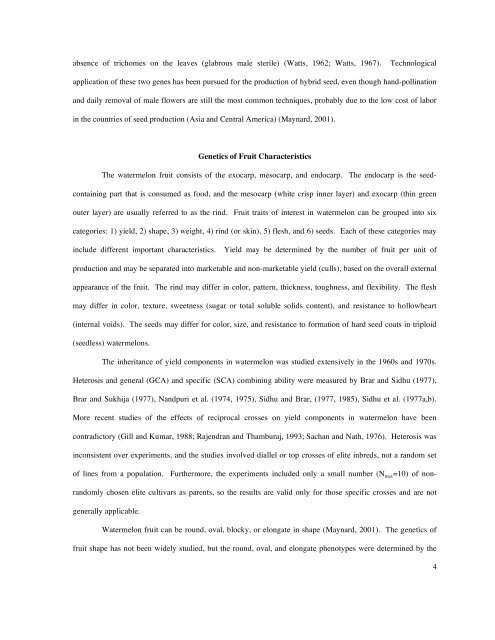Citrullus lanatus (Thunb.) Matsum. & Nakai - Cucurbit Breeding ...
Citrullus lanatus (Thunb.) Matsum. & Nakai - Cucurbit Breeding ...
Citrullus lanatus (Thunb.) Matsum. & Nakai - Cucurbit Breeding ...
You also want an ePaper? Increase the reach of your titles
YUMPU automatically turns print PDFs into web optimized ePapers that Google loves.
absence of trichomes on the leaves (glabrous male sterile) (Watts, 1962; Watts, 1967). Technological<br />
application of these two genes has been pursued for the production of hybrid seed, even though hand-pollination<br />
and daily removal of male flowers are still the most common techniques, probably due to the low cost of labor<br />
in the countries of seed production (Asia and Central America) (Maynard, 2001).<br />
Genetics of Fruit Characteristics<br />
The watermelon fruit consists of the exocarp, mesocarp, and endocarp. The endocarp is the seed-<br />
containing part that is consumed as food, and the mesocarp (white crisp inner layer) and exocarp (thin green<br />
outer layer) are usually referred to as the rind. Fruit traits of interest in watermelon can be grouped into six<br />
categories: 1) yield, 2) shape, 3) weight, 4) rind (or skin), 5) flesh, and 6) seeds. Each of these categories may<br />
include different important characteristics. Yield may be determined by the number of fruit per unit of<br />
production and may be separated into marketable and non-marketable yield (culls), based on the overall external<br />
appearance of the fruit. The rind may differ in color, pattern, thickness, toughness, and flexibility. The flesh<br />
may differ in color, texture, sweetness (sugar or total soluble solids content), and resistance to hollowheart<br />
(internal voids). The seeds may differ for color, size, and resistance to formation of hard seed coats in triploid<br />
(seedless) watermelons.<br />
The inheritance of yield components in watermelon was studied extensively in the 1960s and 1970s.<br />
Heterosis and general (GCA) and specific (SCA) combining ability were measured by Brar and Sidhu (1977),<br />
Brar and Sukhija (1977), Nandpuri et al. (1974, 1975), Sidhu and Brar, (1977, 1985), Sidhu et al. (1977a,b).<br />
More recent studies of the effects of reciprocal crosses on yield components in watermelon have been<br />
contradictory (Gill and Kumar, 1988; Rajendran and Thamburaj, 1993; Sachan and Nath, 1976). Heterosis was<br />
inconsistent over experiments, and the studies involved diallel or top crosses of elite inbreds, not a random set<br />
of lines from a population. Furthermore, the experiments included only a small number (N max=10) of non-<br />
randomly chosen elite cultivars as parents, so the results are valid only for those specific crosses and are not<br />
generally applicable.<br />
Watermelon fruit can be round, oval, blocky, or elongate in shape (Maynard, 2001). The genetics of<br />
fruit shape has not been widely studied, but the round, oval, and elongate phenotypes were determined by the<br />
4
















